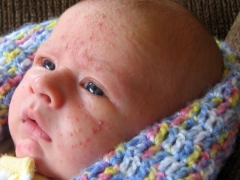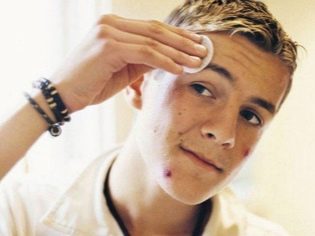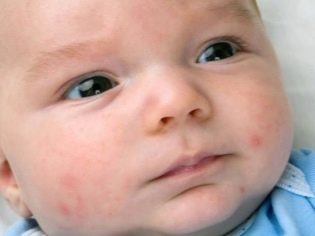Hormonal rash in newborns and infants
Acne on the skin of a newborn puzzles parents. About crumbs take care of him. All the more strange and frightening looks rash on the face, neck, chest.
The appearance of skin rashes is not always a sign of improper or inadequate hygiene or illness. Sometimes the reason lies in the action of hormones. About hormonal rash talk in this article in more detail.
What it is
Acne on the skin of a newborn is not a rare phenomenon; more than a third of all babies suffer from them. As the name suggests, rashes result from hormonal changes.
Normally, it is peculiar to two age categories of children - newborns and adolescents. In the former, acne develops under the influence of maternal sex hormones, in the latter, under the influence of its own sex hormones, the development of which is an indispensable condition for the onset of puberty — the pubertal period.
In babies, a rash does not develop immediately, but usually in the third week of independent life in this world, therefore, the hormonal rash of newborns is often called a three week rash. These terms are not mandatory, so you should not be surprised if skin rashes appear 7-10 days after birth.
In newborns, hormonal rash is considered physiological. It has nothing to do with skin diseases, it does not pose a danger if the skin is properly cared for and does not allow infection of the rash by pathogenic bacteria and fungi.
Hormonal rash in children of other ages (preschool and primary school) - always a reason to visit a doctor, because for such guys normal hormonal changes are not peculiar.
The reasons
In the last trimester of pregnancy, a woman has increased production of estrogen - a hormone that is needed to ensure normal labor. The hormone in large quantities with blood through the uteroplacental blood flow enters the body of the child.
After birth, the residual hormonal background of the mother continues to affect the baby’s body, in particular forcing its sebaceous glands to produce more subcutaneous fat than is required to protect the skin from environmental exposure.
These excess sebum cause obstruction of the sebaceous glands, which are too narrow and therefore physically can not bring all the fat out. So, white, yellowish or grayish rashes - pimples appear on the face, neck, less often on the chest and head of the baby.
The action of the maternal hormone is not infinite, but because of acne in newborns (the medical name is neonatal pustulosis) passes in a few weeks without a trace.
The rate of healing will depend on the individual characteristics of the child - in some pimples pass through a week, in others - only 20-30 days.
Symptoms and signs
Hormonal rash is often localized on the face. Yellowish or whitish pimples - comedones appear on the nose, on the forehead, on the chin. On the cheeks, they act less frequently. Sometimes infants have pimples localized both on the ears and behind them, as well as on the neck and upper chest.
Pimples look like closed the small educations which are not inclined to merge, not having purulent heads. Around the rash is not observed thickening of the skin, no signs of inflammation, redness.
The local immunity of babies is underdeveloped, and therefore infection of pimples by pathogenic bacteria is possible. Such a complicated hormonal rash looks inflamed, often accompanied by suppuration of individual elements.
In newborns, in addition to a rash, hormonal "shakes" are accompanied by swelling of the mammary glands (both in girls and boys), a small swelling of the scrotum in boys and labia in girls.
The skin eruptions in babies never hurt, itch and do not create any inconvenience for the child. They are concerned more with parents than infants themselves.
How to distinguish from allergies?
Distinguishing between the rash that accompanies allergies and the physiological rash is not difficult. To do this, you should carefully examine the baby and note a few differences:
- Location - hormonal rash is localized on the face and neck, allergic can affect any part of the body. A rash on the cheeks is usually allergic, as is the scalp. On the nose and on the forehead, the rash is usually hormonal.
- Appearance - Allergic rashes do not have clear boundaries; some elements of the rash tend to coalesce and form wider lesions. Hormonal rash has clear outlines, never merges and is not accompanied by erythema (redness).
- Related symptoms - an allergic rash gives unpleasant sensations - itching, tingling, whereas the physiological does not itch and does not hurt. Allergies often accompanied by a runny nose, conjunctivitis, general deterioration of the child’s well-being, increased moodiness, problems with sleep and appetite. Hormonal rash does not affect the behavior of the child and his well-being.
Parents of infants often confuse hormonal rashes and allergic rashes, especially since the one and the other in children of the first year of life is a common phenomenon.
How to distinguish from infection?
Many infectious diseases, including typical childhood diseases such as chickenpox, measles, scarlet fever and others are also accompanied by skin rashes. From the hormonal rash to distinguish infectious is also quite simple:
- Location - an infectious rash covers a fairly large area of the skin, it can be scattered throughout the body. Exception - simple herpes, which is localized in the area of the nasolabial triangle, but the herpetic rash has a special characteristic appearance - small vesicles with inflamed edging.
- Appearance - Infectious rashes have clear outlines, as does acne. But they are never comedians - closed pimples, better known among the people as grease fats. In infections, the rash may be watery, purulent, red, punctate, but not whitish or yellow.
- Other symptoms - infections, except for the rash, are always accompanied by a bright clinical picture - fever, respiratory signs - cough, runny nose, changes in the condition of the tonsils, muscle pain, changes in the general condition of the child. Nothing like the usual hormonal rash is not observed.
Treatment
Hormonal rash in newborns does not need treatment. It is enough to monitor the condition of the skin and properly treat hygiene. It is very difficult for young mothers to stay idle, to accept the fact that nothing needs to be done. Therefore, they can facilitate their existence, paying attention to hygienic treatments.
Baby with neonatal hormonal rash can be washed once a day with broth of pharmaceutical chamomile. Trays with calendula or calendula decoction will also be useful.
Squeezing pimples categorically is not recommended, because it will increase the risk of bacterial infection.
It is not worth smearing a hormonal rash with various means, especially with a children's cream or any other fat-based cream. This will only aggravate the process and delay recovery.
A child with a hormonal rash does not need sorbents or antihistamine preparations and ointments, and wiping the rash with alcohol and any alcohol-containing compounds and lotions is generally dangerous.
It is important to just keep an eye on so that the skin is clean, sufficiently moist. To do this, the room should not be hot - not higher than 21 degrees Celsius, and the relative humidity of the air should be at the level of 50-70%.
A common mistake made by parents when a rash appears is increased hygiene. Frequent washing with soap dries the skin, and the sebaceous glands begin to produce subcutaneous fat even more intensively, as a result, new elements of the rash appear.
Therefore, to wash and bathe with a hormonal rash should be no soap at all, and even less so without bactericidal types of soap. Such detergents destroy on the skin surface not only pathogenic, but also beneficial bacteria, as well as a protective layer of children's skin, the so-called “lipid mantle”.
Parents of toddlers should consult a doctor if the rash became inflamed, pimples became purulent and the baby’s behavior changed - he began to eat worse, restlessly to sleep, to be capricious.
In other cases, acne, caused by hormones, is not a cause for concern and parental anxieties.
All about the causes of a rash newborns the doctor will tell Komarovsky in the next video.






























